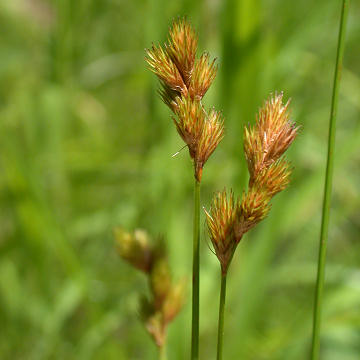

Carex scoparia - (image 1 of 7)
Taxonomy
Family: Cyperaceae
Section Ovales
Habitat
Common in wet prairies and meadows. Also calcareous fens, moist calcareous prairies, open swamps, and shores.
Associates
Calamagrostis canadensis, Thelypteris palustris, Iris virginica, Juncus dudleyi, Onoclea sensibilis, Sagittaria latifolia, Typha latifolia, Mentha arvensis.
Distribution
Newfoundland south to FL, west to British Columbia, OR, and NM.
Morphology
Tufted perennial to 70 cm, the lowest leaves reduced to scales (aphyllopodic); main leaves 1-3 mm wide, shorter than the stems; sheaths ventrally hyaline; spikes 3-8, ovoid to fusiform or subglobose, pale green to dull-stramineous or tan, sessile in an open or often condensed spike 2-4 cm; perigynia lanceolate, 4-5.5 mm x 1.5-2 mm, 2.5-3 times as long as wide, strongly flattened and much wider than the achene; achenes lenticular, narrow, mostly only 0.5-0.8 mm wide.
Notes
Fruiting late May to July
Wetland indicator: FACW
The first photograph is from a planted specimen.
References
Gleason, Henry A. and A. Cronquist. 1991. Manual of Vascular Plants of
Northeastern United States and Adjacent Canada. Second Ed.
The New York Botanical Garden. Bronx, NY
Swink, F. and G. Wilhelm. 1994. Plants of the Chicago Region.
Indiana Academy of Science. The Morton Arboretum. Lisle, Illinois.
|
© Michael Hough 2004 |